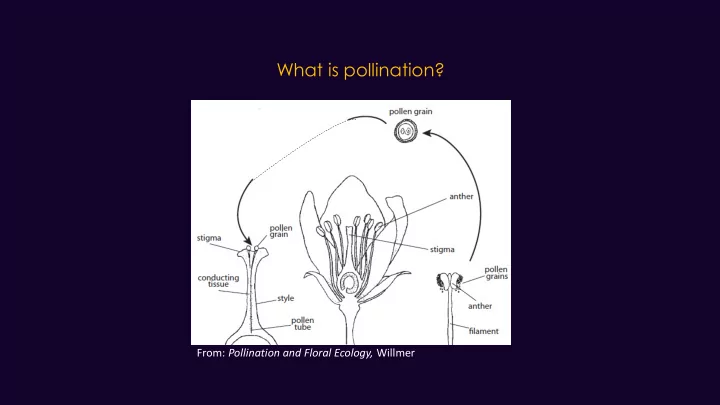

What is pollination? . From: Pollination and Floral Ecology, Willmer
Why animal pollination? .
Pollen Prey Nectar What is animal mediated pollination? U.S. Fish and Wildlife Service Headquarters T. Freiburger Scent Resin . Eltz Elena Albertsen
What isn’t animal mediated pollination? . Pollination by animals IS NOT an altruistic behavior. All mutualisms can (and should!) be thought of as “reciprocal parasitism’s” (Judith Bronstein)
Pollinators differ & plants differ Pollinators Plants • Morphology • Architecture / morphology • Behavior • Mating system . • Resources sought • Phenology • Effectiveness and • Rewards offered efficiency as pollinators • Etc, etc • Etc, etc What is the upshot of this variation?
Coevolution between plants and floral visitors Coevolution between plants and flower visiting animals is well documented . Animals Plant traits Robert Clark, for Evolution Darwin, C. (1888). The various contrivances by which orchids are fertilised by insects. J. Murray. Galen, C. (1996). Rates of floral evolution: adaptation to bumblebee pollination in an alpine wildflower, Polemonium viscosum. Evolution. Schemske & Bradshaw (1999). Pollinator preference and the evolution of floral traits in monkeyflowers (Mimulus). Proceedings of the National Academy of Sciences Strauss, S. Y., & Whittall, J. B. (2006). Non-pollinator agents of selection on floral traits. Ecology and evolution of flowersWhittall, J. B., & Hodges, S. A. (2007). Pollinator shifts drive increasingly long nectar spurs in columbine flowers. Nature Schiestl, F. P., & Johnson, S. D. (2013). Pollinator-mediated evolution of floral signals. Trends in Ecology & Evolution Plants Animal traits Darwin, C. (1888). The various contrivances by which orchids are fertilised by insects. J. Murray. Borrell, B. J. (2005). Long tongues and loose niches: evolution of euglossine bees and their nectar flowers. Biotropica Miller-Struttmann, et al. (2015). Functional mismatch in a bumble bee pollination mutualism under climate change. Science
Pollination syndromes Floral characteristics predict the kinds of pollinators that utilize the species . “Syndromes” are emergent properties of plant — pollinator co-evolution Florian P. Schiestl , Steven D. Johnson, https://doi.org/10.1016/j.tree.2013.01.019
This concept can be useful .
This concept can be useful . David Inouye
But it is not perfect • “Matches” aren’t really perfect • “Everything visits everything” • Many relationships too diffuse • Many other factors also drive floral trait evolution . Strauss, S. Y., & Whittall, J. B. (2006). Non-pollinator agents of selection on floral traits. Ecology and evolution of flowers, 120- 138. Lehtilä, K., & Strauss, S. Y. (1999). Effects of foliar herbivory on male and female reproductive traits of wild radish, Raphanus raphanistrum. Ecology, 80(1), 116-124.
Today’s lab • Visit herbarium • Examine / take notes on specimens . • Finish readings, answer assignment questions
What is an herbarium? .
Figure captions 1 - What are we looking at? Describe the data, not the results 2 - What does it mean? Very brief statement of the take-home point 3 - How do you know? Stats . This is not the results nor is it the discussion section Be concise
Recommend
More recommend